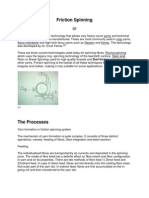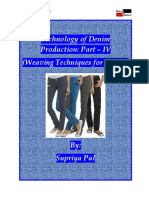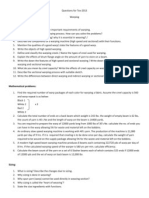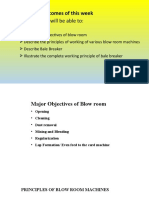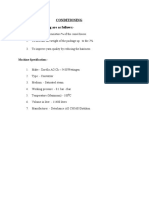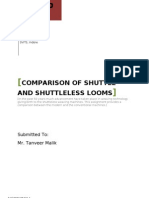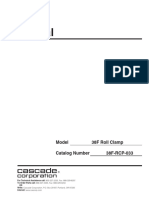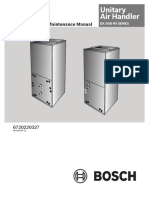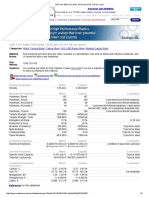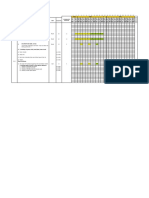Rapier
Rapier
Uploaded by
Sri MeeinaCopyright:
Available Formats
Rapier
Rapier
Uploaded by
Sri MeeinaCopyright
Available Formats
Share this document
Did you find this document useful?
Is this content inappropriate?
Copyright:
Available Formats
Rapier
Rapier
Uploaded by
Sri MeeinaCopyright:
Available Formats
.
Introduction
Rapier weaving today exists in diversified forms. During the last two decades the developments in rapier weaving have been carried out in a rapid continuous way. Rapier weaving machine produces top- quality fabrics from spun yarns such as cotton-wool, camel hair, silk, synthetic fibers and fancy yarns. Todays rapier weaving machine has become fast and exceptionally flexible. It offers a choice of various reed widths, shedding motions, selvedges and filling insertion colors. This makes it suitable for weaving an extended range of articles: fashion fabrics, shirting, denim, suiting, industrial or furnishing fabrics, in one to eight or twelve filling colors or yarns, with a maximum weight of 500 g/m2. Todays rapier weaving machine is designed with modern electronics, with total automation of weaving and central microprocessor control system, also ensuring maximum reliability, amazing user-friendliness, ease-of operation, shorter style changing time, excellent fabric quality, low energy consumption, and optimized insertion cycle for unequalled industrial speed[1-4].
2. History of Rapier
In the past 150 years weaving machinery has gone through the most radical changes. Although the invention of the fly shuttle by John Kay-which doubled the production of hand loom - came in 1733, the development of shuttleless loom, starting with the rapier loom, goes back to 1844, when John Smith of Salford was granted a patent to eliminate the shuttle. Subsequent patents were taken out by Phillippe and Maurice in 1855, W.S. Laycock in 1869, W.Glover in 1874[7]. Rigid rapiers were invented in 1870 and perfected by O. Hallensleben in 1899. The main breakthrough came in 1922 when John Gabler invented principle of loop transfer in the middle of the shed [8-10]. Flexible rapiers of the type used today were proposed in 1925 by R.G.Moya of Barcelona, based on a Spanish patent applied for in 1924. In 1939, another inventor, R.Dewas, introduced the novel idea of grasping the weft at its tip by the giver or a carrier rapier, and then transferring it to the taker or a receiver, in the middle of the shed. In the period up to the beginning of the World War 2 many patents were applied for, but it was only in the 50s and 60s that rapier weaving finally become commercialized and since then has made highly significant progress in achieving the present weft insertion rate of 1,500 m/min plus[11].
3. History of Development of Rapier Technology
Rapier looms vary greatly in both the general strategies of their design, such as the choice of method used to transfer the weft between the rapiers and the types of rapier used- rigid, flexible or telescopic- and in details of mechanism used. These machines find preferential use in the production of with fashion-appeal compared to other methods of weft insertion which are mainly suitable for weaving staple items with limited fashion-appeal. Ease of multicolor weft insertion is fully exploited by rapier looms - many can insert up to 12 colors in any pick-at-will patterning sequence, including their ability to deal with a wide range of yarns and fabric types. The positive rapier drives enables heavy or otherwise difficult yarns to be inserted. The rigid rapier system of weft insertion has the advantage of positive thread transfer in the centre of the shed without any need for guiding the rigid rapiers through the shed and without making contact with the warp thread. However this is at the cost of occupying more floor space, which causes reed width of the rigid rapier to be limited. The
flexible rapier system of weft insertion has the reputation of being most adaptable and most applicable. The outstanding feature of flexible rapier machine is its significant increase in weft insertion rate, greater reed width (460cm), versatility and adaptability. In the last 15 years or so the design of the rapier machine has been revolutionized by new innovations, engineering walkthroughs, automation in processes, introduction of computer technology, electronics and CAD-CAM systems. The weaving industry on the whole has entered a new era of electronics, microprocessors, information technology and their application to the production of woven fabrics. Incorporation of electronic devices and system to weaving machines has become almost inseparable part of the machine. Developments, particularly of microprocessors, have revolutionized the design of the rapier weaving machines, including the weft propulsion technology. The weft insertion elements have been made smaller and lighter in weight[2,4,26-28].
4. Development in Filling Insertion
In the area of filling insertion there are a lot of developments and implementation has been done since few years. These are discussed following.
4.1. Versatility in Colour Insertion by Electronic Insertion
The weft color selectors of todays rapier weaving machine are microprocessor controlled, compact sized ones and can be available in 16, 12, 8, 4 or 2 colors. Picanol developed the Quick Step filling presenter, operates with independent module, each consisting of an electronically controlled stepper motor with presenter needle. The color and weave pattern are microprocessor or jacquard controlled. After the left gripper has taken the presented yarns, the Quick Step needle returns to an intermediary position, so the course of the filling yarn is straight and the tension of the yarn is low and remains constant. The Quick Step filling presenter has several advantages. It is monitored by the machine microprocessor, so the timing for the presentation of the filling yarn is perfectly synchronized with the machine speed and the weave pattern. The filling presenter also provides the ideal position for rethreading. The modules of the Quick Step are interchangeable and there are no mechanical drives, so no maintenance or lubrication is required[6,7]. Dornier offers the Electronic Color Selector (ECS), and the electronic filling tension device with integrated filling stop motion (EFC), are based on state-of-the-art stepping motor technology and are controlled by an external CAN-BUS[6,7,31]. Advantages of the system are; It is monitored by weaving machine microprocessor so timing for presenting for filling yarn is perfectly synchronized with machine speed and weave pattern. The course of filling yarn is low and remains constant. The filling presenter also provides ideal position for re threading. The modules of quickstep are interchangeable.
4.2. Picking Speed
In jacquard weaving upto 12 weft colors give a wide variety of patterning option. The G6500 offers a machine speed of upto 700 rpm and a maximum weft insertion rate of 1620 m/min[6,8].
4.3. Secure Filling Transfer
During centre transfer from the left-hand to the right-hand rapier, the filling is positively controlled and thus securely transferred. The filling is released after the rapier has exited the shed in the open shed position and under absolutely control conditions. In Dornier rapier weaving machine, the highest peak yarn tension is extremely low due to the low rapier speed and positive control. Soft thread clamps with hard metal inserts and precision controlled transfer enable even coarse filament yarns of 2200 dtex with 450 filaments to be securely clamped and inserted[6,7].
Figure 1. Secure filling transfer[7]
Figure 2. Versatile rapier [7]
4.4. Versatility of Rapier Gripper
A new generation rapiers capable of handling even the most difficult of yarns, typical of the latest trends in fashion fabrics. The rapiers are lightweight and compact and mounted at the centre of gravity on the ribbons to reduce wear to the minimum and guarantee maximum accuracy in movement. It facilitates the processing of the widest range of yarn types and counts from fine silk yarns through glass rovings to the coarsest effect yarns. The count range lies between 0.77 tex and 3333 tex. The weft exchange also takes place in slow speed, thus making life far easier for those involved in adjusting the machine setting and at machine start-up[6,7].
4.5. Free Flight Rapier
Free Flight means that hooks no longer guide the rapier tape, so the hooks can no longer damage the yarns by diving into the warp. Picanol developed Free Flight Rapier in their GamMax rapier-weaving machine, which has been specially developed for weaving delicate fabric. The machine has a covered race board for gentle treatment of the warp yarns during beat-up. The Free Flight version of GamMax is especially useful for production of lining, voile, curtains, upholstery fabrics, industrial fabrics, high- twist crepe, air-bags, computer ribbon, spinnaker (soil cloth), glass and Kevlar[5,6].
4.6. Light and Small Rapier Head
The new lightweight guided gripper version enables higher speeds, and since the easier presentation into the gripper clamp requires less filling tension, the number of filling stops is reduced. The light gripper is also smaller, which results in a smoother entrance of the gripper in the shed, ensures less friction on the warp yarns. This reduces the warp breaks[6].
4.7. Versatile and Synchronized Weft Cutter
A perfectly efficient weft cutter mechanism is required for use of a wide range of yarn in rapier weaving machine. Leonardo has the weft cutter having direct gear drive, ensuring constancy and precision and reducing yarn wastage. The rapier head inserts any kind of weft. With the "RotoCut" in G6500, electronically controlled weft cutter, the timing of weft cutting is optimized. The "RotoCut" always cuts the weft at the best possible moment, irrespective of yarn type and material[6,8].
4.8. Electronic Filling Tension Controller
It controls the filling brake ensures a current yarn tensions at any time during insertion cycle. It can be installed for each channel between the pre-winder and entry of fixed main nozzle. It has been designed to slow down the filling at the end of insertion. It thus significantly reduces the peak tension of the pick at the end of the insertion and decrease the tendency of pick to bounce back in the shed. As a result of which the filling tip is stretched correctly with the following features; Lower peak tension in filling yarn. Reduced tendency of filling to bounce back. Inserted pick can be stretched more easily. Adjustments are done by means of machine keyboard and display. The settings can be adopted for each filling yarn. Fewer filling breaks. Fewer machine stops. Better fabric quality. Higher productivity of machine and staff. Weaker filling yarn can be used. Correct setting of filling waste length and consequently less waste. In Picanol GamMax rapier weaving machine, each prewinder is equipped with Programmable Filling Tensioner (PFT). This PFT is microprocessor controlled and ensures optimum yarn tension during the complete insertion cycle. Reducing the basic tension is an important advantage when piecing up weak yarn, while adding tension is an advantage at transfer of the yarns and avoids the formation of loops. This ensures weaving of strong or weak yarns at even higher speeds and also drastically reduces the amount of filling stops and reduces the waste length[3,5,6].
4.9. Prewinder Switch-off Monitoring
A piezo-electric filling detector stops the machine in case of a filling break at prewinder. Picanol offers PSO (Prewinder Switch off) system. The machine continues weaving even in case of a filling break occur on the packages or the prewinder. The prewinder signals the filling breaks and simply switches to the single channel operation instead of two channels[6,8].
4.10. Filling Detection at the End of Insertion
When weaving lively yarns, FDEI (Filling Detector End of Insertion) checks the presence of filling at the end of insertion. This system detects short pick or rebounding fillings and prevents faults in the fabrics at the right hand side. Picanol developed this system[6].
4.11. Pick Finding
At the filling breaks the machine stops and only the harnesses are moved automatically to free the broken pick for removal by the weaver. The requirements that pick finding position is reached with a minimum of reed movements through the beat-up line. In GamMax, the pick finding is simply done by the Sumo motor at slow speed[1,5,7].
4.12. Rapier Cleaning Device
A special air blow system with solenoid valve control to the rapier cleaning devices that ensures cleaning of the rapier when the left hand rapier passes this every time. It produces a modulated blast of air to guarantee better cleaning and thus improve weaving performance. Leonardo offers this Rapier cleaning device[6].
5. Developments in Shedding Mechanism
There are several development has been taking place in the recent time in the rapier loom like;
5.1. Versatility
Today rapier weaving machine can be equipped with a tappet motion with upto 10 healds; positive cams, maximum 8 harness frames, 12 mm pitch; electronic rotary dobby for 12,20 or 24 frames, 12 mm pitch; or an electronically controlled jacquard machine having upto 20,000 hooks[2,3].
5.2. Controllable Shed Geometry
Modern rapier weaving machine offers shed opening free from setting and optimization of the shed geometry. The shed opening is easily adjusted to suit the style in production. The symmetrical shed geometry and very small shed offer lower stress on both the warp threads and filling. Automatic shed leveling on dobby and jacquard prevents starting mark due to yarn stretch caused by a stop at open shed. In GamMax, the shed opening offers optimum geometry combined with a wide range of backrest position. Small or large shed opening can be easily set to suit the article being woven[6,9, 29-30].
5.3. Electronic Setting of Shed Crossing
A unique Picanol feature using AKM allows the weaver to control the aspect and hand of the fabric without even touching the drive chain. A few simple keystrokes on the display are all it takes to let GamMax reset its crossing points. The fabric quality can be checked and the setting copied to another machine within a short time[6,9].
5.4. Variable Shed Geometry
The variable shed opening angles and setting options result in unprecedented precision of the shed geometry in rapier G6500 machine. The shed closure timing is easily set at the touch-screen terminals[8].
5.5. Shortest Drive Path
Picanol offers direct driven of the main shaft and the shedding motion through the main motor. This results in reduced noise levels and consumes less energy[9].
6. Development in Let-off Mechanism
The electronic motor driven let-off supplies the loom with necessary wrap yarn, maintaining the yarn tension constant from full beam to empty beam. Let-off speed is automatically calculated in context with loom speed, weft density, wrap beam diameter &
close loop tension control. Accurate synchronization with main motor in forward & reverse direction in addition with remarkable latest features supports to minimize the beginning & ending marks thus, enhancing the grade & quality of the fabric. Besides this, it enables cramming/density design possible[10]. The let-off & take up is synchronized rigidly with main motor in forward as well as reverse direction. With the take up electronic system the weft density variation doesnt need any more mechanical interruptions on the loom, it just need setting parameters on the fly of the key.
Figure 3. Synchronized Electronic Let-off and Take-up mechanism[7]
The great advantages are: Cramming pick finding- forward & reverse. Controlled synchronized movement during start, stop & running It boost quality & efficiency of the product A great value addition to the weaving machine. The accurateness in settings & functioning introduces an easy way to adjust weft density for highest fabric weight & least yarn consumption. The most remarkable thing is that it creates lots of alternatives for the weaver to manage the fabric marks & quality. In addition pc connectivity & internet options offer loom data monitoring either locally as well as from a remote place too. The let-off motion is electronically controlled with load cell for different setting. Warp tension can be set by digital system[11-13]. Warp beams with 800, 1000 and 1200 mm with following configuration can be available: Twin beam with differential drive. Twin beam with bilateral let- off. Double simple beam or double twin beam. Somet Thema Super Exel offers electronic warp let-off and fabric wind-up by means of an electronic gear system[7, 14]. The precision of the electronic gear system synchronizes with the fabric take-up. A double warp let-off for heavy fabrics ensures microprocessor controlled constant warp tension. This guarantees easy let-off of both half-beams. The reading system of the warp tension is independent for the two beams. In Leonardo, the warp let-off is optimized by a unique and extremely versatile backrest support ensuring significant advantages even in the case of heavy weight fabric. Leonardo is also equipped with a twin beam version, with independent drive system for the two beams, ensuring constant warp tension[6,7,9]. Let-off and take-up motions are identical in construction, simplifying handling as well as spare part inventory. Each motion utilizes a resolver as the measuring system, connected together with the sensor to a control circuit. Even when weaving with twin beams the precision of the entire system is maintained. The accuracy of setting the warp tension on the display is in the region of 1 gram and in the case of the take-up, up to 0.01 pick/cm[7,15].
7. Developments in Take-Up Mechanism
The take-up motion is also electronically controlled and synchronized with let-off motion. Inside the machine the cloth is wound on to a 600 mm diameter cloth beam. External cloth beam on to batching motion upto 1800 mm cloth roll diameter is also available. The required pick density can be programmed on the microprocessor keyboard or the jacquard control unit. The accuracy of the setting ensures easy to adjust of the pick density of the fabric for optimum fabric weight and minimum yarn consumption. The electronic take-up also makes it possible to weave fabric with variable pick densities[2,6].
8. Drive to the Reed and Rapier
The rapier drive system is derived from positive cams, manufactured from a single piece of steel, which also incorporates the cams for the sley drive. High speeds are possible due to the special profile of the cams governing the movement laws of the rapier[16]. The profile is designed to transmit the lowest possible acceleration to the filling yarns. In Dornier rapier weaving machine, type PS, the rapier and reed are driven through gearboxes with complementary cam assemblies with exceptionally precise control. Two high- precision synchronized gearboxes, one at each side of the machine, provide the drive for the filling system and reed beat-up. The compact construction and massive drive dimensioned components create little vibration and a high degree of functionality, thus achieving a secure centre transfer of the filling. A continuous lubrication system provides for increased performance, low maintenance, and high longevity of the new gearbox generation[1,7]. Picanol has developed the oscillating rotational motion of the rapier wheel generated by a simple, robust, three-dimensional crank system, ensuring reliability, and requiring no maintenance or adjustment. The sley is driven by a set of complementary cams with cam followers on both sides of the machine. They run in an ion bath connected to the central lubrication system. The sley with the reed holder is perfectly balanced and provides a powerful beat-up over the whole weaving and ensuring less vibration. When weaving heavy and densely beaten fabrics, the machines sley system has a strategic role[5, 6, 9]. For this reason, Leonardo developed several sley drive units (two for narrow loom and three for double-width machine) fixed on the main cross bar and coupled to the connecting shafts. The optimized geometry of the kinematics, strengthening of the camshafts in the balancer and cam-reading shaft, centralized lubrication for the drive units all these help to guarantee big advantages in terms of stability, lower noise levels and low maintenance requirement.
Figure 4. Moto Leno[7]
9. Selvedge
There is more than one technology available for producing selvedge in modern high speed rapier looms. These are Moto leno, ELSY, disco leno, power leno has been used by different machinery manufacturer. Dornier offers revolutionary selvedge formation device with decisive advantages. The, 2end full-turn leno type Moto Leno, controlled in direct relation with weave requirements, variations in pick density and fabric construction, is
freely programmable. Warp end breaks in the selvedge area are significantly reduced. The inexpensive alternative to tucked selvedge is the 2-end full turn leno type Moto Leno with synchronous motor drive.
Figure 5. Disco leno[7]
Based on Moto Leno, the modular designed Moto Eco double-disc leno is also available. While one leno forms the fabric selvedge, the second leno replaces the catch selvedge. All the functions are easily set directly on the machine display. In the DiscoLeno, the company presents a 2-thread full-cross leno device with synchronous motor drive, a feature unique in the construction of weaving machines. It operates with normal king and flanged bobbins and copes under weave control with any pick density variation and fabric construction. The advantages both in terms of machine and weaving technology of Moto Leno and Disco Leno are following Wear-free operation at maximum speeds of up to 1200 rpm. The use of any types of bobbins. Full reversibility of the leno device. Simple leno threads monitoring by means of conventional warp stop motion droppers. Use of full leno device for all types of fabric. Shed closing can be chosen freely in the display separately for each leno device. Elimination of 2 base heald frames including drive. Reduction in leno yarn breaks to an absolute minimum due to short front shed and low stress on leno thread. QSC-compatible. The leno devices remain as an autonomous device when a style change is introduced on the weaving machine. No bulking of the fabric selvedges caused by the leno device, no differences in tension relative to the fabric selvedge. Good and stable interlacing thanks to full leno technique. Can be used without any limit on the number of heald frames. Can be retrofitted with the CAN-bus control system. PowerLeno is a completely new technology for producing leno fabrics. The core elements of this innovation are the guide bar and the eyeleted reed. They replace the costly, wearprone leno healds used hitherto, creating the conditions for moving into a new dimension of productivity and high efficiency in modern weaving.
Figure 6. power Leno[10]
The working principle is like that.
The leno thread (blue) runs through the apertures in the guide bar and eyeleted reed; the stationary end (red) has been drawn into the eyelet of the eyeleted reed. The shed is open for weft insertion. Following weft insertion the guide bar moves upward; the eyeleted reed moves in the opposite direction until the leno thread is above the stationary end. Now the guide bar is displaced sideways until the leno thread is on the opposite side of the aperture in the eyeleted reed. . Now, when the guide bar moves downward and the eyeleted reed upward, the leno thread comes to lie over the stationary end. The shed is open for the next weft insertion. The system is ready for the next sequence in the opposite direction. PowerLeno sets the new standard for cost effective production of leno fabrics. PowerLeno means higher productivity coupled with a degree of reliability never previously achieved. PowerLeno gives: Optimum fabric quality and maximum efficiency thanks to reduced yarn loading User-friendliness, with easy, straightforward machine operation A wide range of applications, with working widths up to 540 cm Increased productivity thanks to maximum machine performance Minimal wear thanks to low masses and less movement Higher overall cost-effectiveness in leno fabric production. Picanol has developed the unique ELSY full leno selvedge motion, electronically driven by individual steeper motors. The selvedge crossing can be programmed or the microprocessor independently of the shed crossing even while the machine is in operation. The earliest position for rethreading can be set by a simple push of a button, when the machine starts the selvedge system automatically returns to its original position. In Suizer G6500, the electronically controlled selvedge-forming unit can be adjusted at the terminal while the machine is running. The selvedge forming units are separately driven and ensure clean selvedge formation. The timing of the shed closure for the left and right selvedges is freely programmable via the terminals[5,10,12,32].
10. Quick Style Change
The quick style change system, developed by several rapier weaving machine manufacturers in their own versions ensures quick style change (less than 30 min). With quick style change just one person can carry out a style change in less than 30min. This is achieved by swapping the whole back part of split frame, with the warp beam, the back rest and the supports, the warp stop motion the harness and the reed. This ultimately increases the productivity of the loom shed. The quick style change system is not just a machine set-up but also an integrated system that allows the movement of the preparation room of some operations normally done on the weaving machine. The knotting operations and the drawing-in of the warp can be done in the preparation department, thus improving the workload and avoiding longer machine downtime. Leonardo is integrated with the "VQSC" Quick Style Change System, which ensures reduced machine downtime and the extra time needed to unload the machine, to adjust the setting and to load the new style as far as possible. Also the warp stop motion,
frame, reed, and beam unloading/loading operation have been made far easier with the introduction of rational and reliable technical solution. Picanol developed QSC, Quick Style Change System in which the style change is achieved by swapping the whole back part of the split frame, with the warp beam, the back rest and the supporting warp stop motion, the harnesses, and the reed. Additionally this unique system makes it possible to carry out the entire article related setting on the warp side, outside the weaving shed before the style change. This ultimately reduces the labor requirement and thus increases the loom efficiency[1, 6, 7, 9, 12, 33] with the following benefits and advantages;. Reduce machine down time. Interference losses due to simultaneous stops are practically non-existent. Fewer personal required for warp and article changes in weave room. Warp changes can be replaced by style changes, enabling the load on the tying and drawing in equipment to be balanced instead of having two bottlenecks.
Figure 7. Automatric start mark prevention[7]
11. Automatic Start Mark Prevention
Automatic Start-mark Prevention (ASP) prevents starts mark at the source. The simple functionality of automatic start-mark prevention saves time and significantly contributes toward quality improvement. All the functions outlined in the illustration can be simply called up on the machine display and change as required.
12. Electronic Control Technology
The electronics of modern rapier weaving machine are based on multiprocessor architecture with 32-bit technology. Data transfer between the various sub units of the machine is via a CAN- BUS[17], permitting fast and reliable exchange of data both internally and externally. The terminal has a graphic display in which various functions of the warp let-off, cloth take-up, weft feeder, etc, can be programmed easily and. clearly. The modern electronics give the following advantages: Ease of operation. High fabric quality irrespective of speed. Pick density alterable while the machine is in operation. Immediate help trouble-shooting problem. Self-adjusting stop position of the machine. Microprocessor controlled central forced lubrication system. Storage and monitoring of all the production data, efficiently. Machine function control, pattern weave, warps tension, pick density. Pick finding control and the elimination of stop marks by means of pro-set programs. Control and report of style change timing. Quick control of the electronic functions (self diagnostics and auto check up) and monitoring of the machinery functions for protection[18-20].
Bi-directional communication between the weaving machine and the central production computer. Speed set-up. Electronic weaving speed variation depending on the characteristic of the yarn being used. Control of warp let-off and fabric take-up. Electronic control of the filling tension. Transfer of setting and production parameters of a fabric style, to other machine with the help of memory cards. In Picanol GamMax, most of the machine functions are digitally controlled. All the machine settings can be digitally stored and transferred. The electronic terminal on GamMax monitors and controls all machine functions. Its LCD screen has self explanatory menus and enables the weaver to set the weaving parameters in a very user-friendly way. GamMax is also Internet- enabled. The GamMax terminal features wireless communication through a USB memory stick or key tag, permitting robust, flexible, handy and reliable operation. Suizer G6500 offers "Smart Weave" - intelligent pattern data programming. "Smart Weave" offers fabric designer intelligent support in the preparation of weaves design and picks repeats. The G6500 control interface is a userfriendly, Internet-ready touch screen terminals. The logical structuring with selfexplanatory Pictogram guides the operators to the desired function simply and with a minimum of keying. In Leonardo, the computer system is based on the CAN-BUS system. This drives and controls all the main textile and mechanical function. With the CAN-BUS in mind, a new controller has been developed, called the FULLTRONIC. This co-ordinate all loom functions instant by instant, from the operating conditions of the various mechanisms to each individual response: heald movement, color to be selected, warp tension, density of the weft in the fabric, plus the messages describing the status of the lubrication circuit. Monitoring takes place at a frequency of more than 700 messages/sec. The Dornier rapier-weaving machine, type PS, has control cabinet with integrated CANBUS and various modules for start, stop, warp let-off and fabric take-up as well as start mark prevention. The Dornier Customer Service Department can directly access machine displays - trouble shooting online. The DoNet Global Communication Network offers quick location and transportation of setting instructions, remote diagnostics[1,2,6,7,9,25].
13. Machine Main Drive
The Dornier rapier-weaving machine is driven with a continuously running motor over a magnetic brake-clutch unit. Intelligent electronics monitor the acceleration time and control the exceptionally short brakes time. This guarantees the full dynamics of reed beat-up on the first pick, thus eliminating start mark. Picanol has developed the Sumo main motor. It drives the weaving machine directly, without belt transmission or clutch and brake. The machine speed is controlled electronically, which considerably reduces the setting time. With the Sumo motor it is possible to continuously adapt the machine speed pick-by-pick to match the strength of the filling yarn. With the help of this system, it is no longer necessary to keep the machine speed continuously low if there is one weaker filling yarn in multi-channel weaving. With the Sumo motor it is possible to continuously adapt the machine speed pick-by-pick to match the strength of the filling yarn. With the
help of this system, it is no longer necessary to keep the machine speed continuously low if there is one weaker filling yarn in multi-channel weaving. The advantages of Sumo motor are Saving on energy consumption of more than 10% in comparison with conventional clutch and brake configuration. Machine speed setting is done accurately and completely, electronically via the keyboard of microprocessor. This reduces the setting time to zero. Speed setting is easy to copy to other machine either with electronic set card or with production computer with bi-directional communication. Automatic pick finding becomes faster, which significantly reduces the down times for repairing filling and warp breakages. The machine can always work at optimum weaving speed in function of quality of the yarn, the number of frames, and fabric construction[5-7,9,11,24].
14. Conclusions
Todays rapier weaving machine has become fast and exceptionally flexible. It offers a choice of various reed widths, shedding motions, selvedges and filling insertion colors etc. The weft color selectors of todays rapier weaving machine are microprocessor controlled, compact sized ones and can be available in up to 16 colors[21]. The maximum weft insertion rate achieved is 1620 m/min. The versatile rapier head van handle a count range lies between 0.77 tex and 3333 tex. Rapier head has become smaller, lighter and able to free-flight. Filling insertion system is microprocessor controlled and synchronized with other mechanisms. Shedding mechanism has become more versatile. Let-off and take-up mechanism is synchronized with other mechanisms so that minimum start-up marks produced in fabric in large diameter of take-up roll[22-23]. Drive mechanism to reed and rapier provides minimum acceleration to the filling so that minimum filling breaks occur. Fully programmable high speed selvedge formation devices such as Moto leno, Disco leno, Power leno and ELSY are developed to cope up with high speed rapier machines.
References
[1] [2] [3] [4] [5] [6] [7] [8]
Model development; Textile Magazine; Issue4; 2008; pp36-39 Amit A Jadhav, Modern development in weaving; The Indian Textile Journal; July 2007; pp22-25 Weaving Technology Advances and Challenges II: Journal of Textile and apparel, Technology and management; Volume3, Issue 1, Summer 2003; pp1-10 At the rapiers edge?; Textile Magagine; June 2001; pp16-22. Picanol at India ITME 2008; Press Release Ieper, September 5, 2008 Sound weaving, Feature article; The American Society of Mechanical Engineers; March; 2008 Ttimer S. T. and Dawson R. M., Filling insertion by rapier: a kinematic model. Text. Res. Jnl 58, 726-734 (1988). Adanur S. and Mohamed M., Analysis of yarn motion in single-nozzle air-jet filling insertion. J. Text. Inst. 83, 45-68 (1992).
[9] [10] [11] [12] [13]
[14]
[15]
[16] [17]
[18] [19] [20] [21] [22] [23] [24] [25]
[26] [27]
Suematsu M., Measuring phase wave velocity of thread by longitudinal pulse wave under various tensions. J. Text. Mach. Jpn (English Edn) 5, 39-41 (1959). Vangheluwe L., Study of the time dependent mechanical properties of yams for weaving. Ph.D. thesis, Department on Textiles, University of Gent (1992). Adanur S. and Mohamed M., Analysis of yarn tension in air-jet filling insertion. Text. Res. Jnl 61, 259-266 (1991). Weinsd6rfer H. and Lange A., SchuBfadenzugkr~ifte an einer Greiferwebmaschine. Melliand Textilber.71,507-5:2 (1990). Brandt J, Drechsler K, Arendts F-J. Mechanical performance of composites based on various three-dimensional woven-fibre preforms. Composites Science and Technology 56:3816: (1996). Cox BN, Dadkhah MS, Morris WL, Flintoff JG. Failure mechanisms of 3D woven composites in tension compression and bending. Acta Metallurgica et Materialia;42: 3967 84 (1994). ASTM D4018-81, Standard test method for tensile properties of continuous filament carbon and graphite yarns, strands, rovings, and tows, Annual Book of ASTM Standards, vol. 15.03, American Society for Testing and Materials, Philadelphia, (1997). Kuo WS, Fang J, Lin HW. Failure behavior of 3D woven composites under transverse shear. Composites: Part A 34:56175 (2003). Lee L, Rudov-Clark S, Mouritz AP, Bannister MK, Herszberg I. Effect of weaving damage on the tensile properties of three-dimensional woven composites. Compos Struct 57:405 13 (2002). Callus PJ, Mouritz AP, Bannister MK, Leong KH. Tensile properties and failure mechanisms of 3D woven GRP composites. Composites: Part A 1999;30: 127787. Yi HL, Ding X. Conventional approach on manufacturing 3D woven performs used for composites. J Ind Textiles;34:3950 (2004). Cox BN, Dadkhah MS, Morris WL. On the tensile failure of 3D woven composites. Composites: Part A 27A:44758 (1996). Mahadik Y, Robson Brown KA, Hallett SR. Characterisation of 3D woven composite internal architecture and effect of compaction. Composites: Part A ;41: 87280 (2010). Potluri P, Sagar TV. Compaction modelling of textile preforms for composite structures. Compos Struct 86:17785 (2008). Lee B, Leong KH, Herszberg I. The effect of weaving on the tensile properties of carbon fibre tows and woven composites. J Reinf Plast Compos 20:65270 (2001). Seyam A M, Advances in Weaving and Weaving Preparation at ITMA 99, Textile Progress Journal, Volume 30, Number 1 / 2, pp. 22-40, (2000). Seyam A M, Applications of On-line Monitoring of Dynamic Forces Experienced by Needles during Formation of Needled Fabrics, International Nonwovens Journal, vol. 8,No. 2, 55-60, (1999). Pourdeyhimi B, and Batra S K, Implications for the Nonwovens Industry, Textile Progress Journal, Vol. 30, Number 1 / 2, 51-67, (2000). Abdelfattah M S, Weaving Technology: Advances and Challenges II, vol. 3, Issue 1,
[28] [29]
[30] [31] [32] [33]
Summer (2003). Abdel-Fattah M. S, ITMA Technology: Weaving & Weaving Preparation, Textile World, Feb., (2012). Gokarneshan N, Jegadeesan N and Dhanapal P, Recent innovations in loom shedding mechanisms, Indian Journal of Fiber & Textile Research, Vol. 35, pp. 85-94, March (2010). Szosland J, Shedding without dynamic warp loading- the possibility of forming new woven structure, AUTEX Research Journal, vol. 12, pp 38, (2002). Baolin Z, Principles of Weaving, China Textile Press, Beijing, PR China), pp. 21-23, (2002). Yueyang Guo, Ruiqi C, A new type of microprocessor controlled positive dobby, Indian Journal of Fibre and Textie Research, vol. 28, pp. 275, (2003). Staff Reports, Advances in weaving machinery offers bolstered productivity and efficiency, Journal for Asia on Textile and Apparel, Dec., (2010).
You might also like
- Study of Transmitted Speed of Drafting Zone On Roving Frame (FL-16) and Ring Frame (Ry-5) by Gearing Method.Document5 pagesStudy of Transmitted Speed of Drafting Zone On Roving Frame (FL-16) and Ring Frame (Ry-5) by Gearing Method.Nain JNo ratings yet
- Modern Cotton Spinning Machinery, Its Principles and ConstructionFrom EverandModern Cotton Spinning Machinery, Its Principles and ConstructionNo ratings yet
- Friction SpinningDocument8 pagesFriction SpinningJoshi ParthNo ratings yet
- Summative Test No. 2 Health 6Document1 pageSummative Test No. 2 Health 6Karen Kichelle Navarro Evia100% (2)
- Circuit Breakers PresentationDocument49 pagesCircuit Breakers PresentationSyed Muhammad Munavvar Hussain89% (19)
- Rafi AssignmentDocument20 pagesRafi AssignmentsatexNo ratings yet
- Fabric IV PPT MahasinDocument12 pagesFabric IV PPT MahasinS.m. MahasinNo ratings yet
- Yarn Preparation For Weaving IDocument18 pagesYarn Preparation For Weaving IKathirrveluSubramainan0% (1)
- 5195 PDFDocument38 pages5195 PDFIbrahim Khalil Jafrani0% (1)
- Count" of Yarn Folded YarnsDocument6 pagesCount" of Yarn Folded Yarnssakshi ranadeNo ratings yet
- CV %Document28 pagesCV %Sanjit janaNo ratings yet
- Calculation of Yarn SpinningDocument4 pagesCalculation of Yarn SpinningMohammed Atiqul Hoque ChowdhuryNo ratings yet
- Jacquard Shedding MechanismDocument10 pagesJacquard Shedding MechanismShanto MaloNo ratings yet
- Experiment No 3 To Calculate The Total Draft and Draft Constant of The Given Carding MachineDocument4 pagesExperiment No 3 To Calculate The Total Draft and Draft Constant of The Given Carding Machinetextilian1419No ratings yet
- G 35 Ring Spinning Machine Brochure 2161-v2 en 21541Document20 pagesG 35 Ring Spinning Machine Brochure 2161-v2 en 21541Aizaz ShahNo ratings yet
- Shedding DobbiesDocument63 pagesShedding Dobbiesarunmythreyee100% (4)
- Ring SpinningDocument11 pagesRing SpinningShahid MahmoodNo ratings yet
- Fundamentals of Textile Machines and ProcessesDocument75 pagesFundamentals of Textile Machines and ProcessesAbi NikilNo ratings yet
- Autoconer Automatic Winding MachineDocument8 pagesAutoconer Automatic Winding MachineAbhay KumarNo ratings yet
- Ring Spinning Vs All Technologies Part 2Document29 pagesRing Spinning Vs All Technologies Part 2SOhaib KazmeNo ratings yet
- Questions For Tex-2013Document2 pagesQuestions For Tex-2013Emdad SarkerNo ratings yet
- F CA-blowroom Lowres MarzoliDocument28 pagesF CA-blowroom Lowres MarzoliAshiqueNo ratings yet
- Group-6 LAB REPORT 2 TEX3104 ID 191-267-801Document7 pagesGroup-6 LAB REPORT 2 TEX3104 ID 191-267-801Minions MinionsNo ratings yet
- Figure: The Relanit Contra Knitting ActionDocument1 pageFigure: The Relanit Contra Knitting Actionmobarok2613100% (1)
- Comber: Construction Design of A Nipper in Comber MachineDocument7 pagesComber: Construction Design of A Nipper in Comber Machinemahmuda chowdhuryNo ratings yet
- Introduction To DrawframeDocument23 pagesIntroduction To DrawframeMujahid MehdiNo ratings yet
- Auxilliary MechanismsDocument20 pagesAuxilliary MechanismsVenkatesh BairabathinaNo ratings yet
- To Study Effect of Comber Noil Percentage On Yarn Quality: ArticleDocument12 pagesTo Study Effect of Comber Noil Percentage On Yarn Quality: Articlelalit kashyapNo ratings yet
- Rieter Comber E86 Brochure 2852 v4 enDocument24 pagesRieter Comber E86 Brochure 2852 v4 enRj ShajahanNo ratings yet
- Beat UpDocument10 pagesBeat UpAsifur RahmanNo ratings yet
- Weaving Machines (Looms)Document95 pagesWeaving Machines (Looms)Amrin Niaz100% (1)
- Ring Frame Inverter DriveDocument11 pagesRing Frame Inverter Driveakshay Singh100% (2)
- Patterning in Weft Knitting: Waqas AshrafDocument33 pagesPatterning in Weft Knitting: Waqas AshrafHifza khalidNo ratings yet
- Dividend, PPI and Change Places in TakeDocument16 pagesDividend, PPI and Change Places in TakeSai Prasad Sahoo SonuNo ratings yet
- Study On Different Types of Action Involved in Carding MachineDocument7 pagesStudy On Different Types of Action Involved in Carding MachineAbhishek BiswasNo ratings yet
- Picking in Projectile LoomDocument2 pagesPicking in Projectile LoomAniket Khot100% (2)
- Fabric - Garment Length MCDocument2 pagesFabric - Garment Length MCsacchashuddhoNo ratings yet
- Ring Frame CalculationDocument14 pagesRing Frame CalculationMuhammad Munirul AlamNo ratings yet
- Advances in Weaving Technol...Document9 pagesAdvances in Weaving Technol...Fabric Club100% (1)
- Dobby Shedding Mechanism - Classification - Types - WorkingDocument9 pagesDobby Shedding Mechanism - Classification - Types - Workingakshay SinghNo ratings yet
- Unimix LB7 4Document2 pagesUnimix LB7 4MY Lê Thị Trà100% (2)
- Learning Outcomes of This Week: The Students Will Be Able ToDocument24 pagesLearning Outcomes of This Week: The Students Will Be Able ToTalha saeedNo ratings yet
- CH 3Document18 pagesCH 3Marsimoy Abdiikeet BedaneNo ratings yet
- Yarn Manufacturing Tandem CardingDocument5 pagesYarn Manufacturing Tandem CardingIndrajit BoseNo ratings yet
- Objects of Conditioning Are As FollowsDocument7 pagesObjects of Conditioning Are As FollowssachinnmimsNo ratings yet
- Winding Efficiency and CalculationDocument16 pagesWinding Efficiency and CalculationTanzila NusratNo ratings yet
- Comparision of Shutlleless and Shuttle LoomsDocument13 pagesComparision of Shutlleless and Shuttle Loomslohitbakore50% (4)
- E65 ComberDocument18 pagesE65 Comberashar khanNo ratings yet
- Comparative Study On Ring, Rotor and Air-Jet Spun Yarn: Sharif AhmedDocument14 pagesComparative Study On Ring, Rotor and Air-Jet Spun Yarn: Sharif Ahmedgizex2013No ratings yet
- Lecture 8Document62 pagesLecture 8fekadeNo ratings yet
- Friction SpinningDocument39 pagesFriction SpinningPåñdît ẞhyãmãñtãk MãñîNo ratings yet
- WarpingDocument10 pagesWarpingKalyan Ray GuptaNo ratings yet
- Water Jet Weaving Machine PrincpleDocument2 pagesWater Jet Weaving Machine PrincpleSajjad Ashraf100% (1)
- Analysis of The Imperfection Index (Ipi) Value of Carded Yarn Produced by Using Different Diameter Spacers On The Ring Frame Spinning MachineDocument7 pagesAnalysis of The Imperfection Index (Ipi) Value of Carded Yarn Produced by Using Different Diameter Spacers On The Ring Frame Spinning MachineUtsho ParvezNo ratings yet
- Blow RoomDocument108 pagesBlow RoomnikitaNo ratings yet
- List of Machine For Opening and Blow Room SectionDocument27 pagesList of Machine For Opening and Blow Room SectionRaj RahadNo ratings yet
- Yarn FaultDocument17 pagesYarn Faultalireza vahabi100% (1)
- Jute SpinningDocument20 pagesJute SpinningAbdus Salam Ratan100% (1)
- Blowroom 2Document27 pagesBlowroom 2Abhi ParamNo ratings yet
- Jacquard SheddingDocument3 pagesJacquard SheddingAshiksajjatNo ratings yet
- Weaving - Weaving Mechanism - Classification of Weaving MachinesDocument3 pagesWeaving - Weaving Mechanism - Classification of Weaving Machinessaranya naren100% (1)
- Water PipeDocument8 pagesWater PipeThanhquy NguyenNo ratings yet
- CHEMISTRY PROJECT-1 (1)Document17 pagesCHEMISTRY PROJECT-1 (1)gaurii2907No ratings yet
- Ieo Sample Paper Class-8Document2 pagesIeo Sample Paper Class-8PRADEEPTI VIIANo ratings yet
- Repeat BreederDocument144 pagesRepeat Breederdrjyotivet100% (1)
- Ashenafi TesfayeDocument14 pagesAshenafi TesfayeToke BekeleNo ratings yet
- Paper PencilDocument12 pagesPaper Pencilscribd downloadNo ratings yet
- Catalogue April 2017Document37 pagesCatalogue April 2017Mahesh DhakaNo ratings yet
- Electronics Module G10 Q2 Week 3 PDFDocument26 pagesElectronics Module G10 Q2 Week 3 PDFFlorence FernandezNo ratings yet
- P6248 1.7 GHZ (Typical) Differential Probe Service ManualDocument55 pagesP6248 1.7 GHZ (Typical) Differential Probe Service ManualShivam GaunsNo ratings yet
- JCTVC-G Notes d9Document253 pagesJCTVC-G Notes d9democracy jattNo ratings yet
- Column Guide VDS OptilabDocument7 pagesColumn Guide VDS Optilablidysprasca100% (1)
- PPPDocument4 pagesPPPsandeepNo ratings yet
- Surtron 50d CatalogueDocument2 pagesSurtron 50d CatalogueeliezerNo ratings yet
- CR420Document56 pagesCR420Gikcoklat AmuntaiNo ratings yet
- Pakistan Studies: Paper 2Document8 pagesPakistan Studies: Paper 2mstudy123456No ratings yet
- The Poison Table Revisited V1.4.1 EndfassungDocument16 pagesThe Poison Table Revisited V1.4.1 EndfassungEm KowalskyNo ratings yet
- 38F RCP 033Document22 pages38F RCP 033milton apraezNo ratings yet
- Tinubu Speech Key HighlightDocument4 pagesTinubu Speech Key Highlightgadebowale21No ratings yet
- AHU Series Unitary Air Handler: Installation and Maintenance ManualDocument32 pagesAHU Series Unitary Air Handler: Installation and Maintenance ManualaklatreaderNo ratings yet
- Test 7 - Vaneesa JackemanDocument20 pagesTest 7 - Vaneesa JackemanShuja AbbasNo ratings yet
- AISI 1141 Steel, Hot Rolled, 19-32 MM (0.75-1Document2 pagesAISI 1141 Steel, Hot Rolled, 19-32 MM (0.75-1PrasadNo ratings yet
- Pharmaceutical-Chemistry PDFDocument1 pagePharmaceutical-Chemistry PDFDhruba Jyoti Baruah0% (1)
- Blood Cell ObservationDocument4 pagesBlood Cell ObservationMuhammad Rizal PrihartadiNo ratings yet
- Routine Maintenance Schedule WorkDocument3 pagesRoutine Maintenance Schedule WorkM Amir Asyraf MusaNo ratings yet
- Discussion Skills Assessment Practice - TemplateDocument2 pagesDiscussion Skills Assessment Practice - TemplatechuatebamiNo ratings yet
- CA1000 Vs CA1010 - PPG TemplateDocument1 pageCA1000 Vs CA1010 - PPG TemplateAstari Putri NuarisaNo ratings yet
- Brasa Brazilian SteakhouseDocument1 pageBrasa Brazilian SteakhousejordiemolnarNo ratings yet
- Civil QC Interview NotesDocument7 pagesCivil QC Interview NotesanujkumarNo ratings yet


